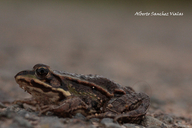|
Pelophylax esculentus (Linnaeus, 1758)
Edible Frog | family: Ranidae genus: Pelophylax |
 © 2014 Alberto Sanchez-Vialas (1 of 66) |
|
|
|
Description Distribution and Habitat Country distribution from AmphibiaWeb's database: Albania, Austria, Belarus, Belgium, Bosnia and Herzegovina, Bulgaria, Croatia, Czech Republic, Denmark, Estonia, France, Germany, Hungary, Italy, Latvia, Liechtenstein, Lithuania, Luxembourg, Moldova, Republic of, Montenegro, Netherlands, Poland, Romania, Russian Federation, Serbia, Slovakia, Slovenia, Sweden, Switzerland, Ukraine. Introduced: Spain, United Kingdom.
In general, R. esculenta is very similar to R. lessonae in ecology but it also occurs in some habitats of R. ridibunda. As a rule, it lives in habitats which are intermediate in their parameters between the two parental species: floodland lakes, overgrown ponds, river pools, channels, ditches etc. However, R. esculenta avoids very large pools with flowing water and does not enter dense forests. Life History, Abundance, Activity, and Special Behaviors Relation to Humans Comments
References
Bannikov, A. G., Darevsky, I. S. and Rustamov, A. K. (1971). Zemnovodnye i Presmykayushchienya SSSR [Amphibians and Reptiles of the USSR]. Izdatelistvo Misl, Moscow. Bannikov, A. G., Darevsky, I. S., Ishchenko, V. G., Rustamov, A. K., and Szczerbak, N. N. (1977). Opredelitel Zemnovodnykh i Presmykayushchikhsya Fauny SSSR [Guide to Amphibians and Reptiles of the USSR Fauna]. Prosveshchenie, Moscow. Gasc, J.-P. (1997). Atlas of Amphibians and Reptiles in Europe. Societas Europaea Herpetologica, Bonn, Germany. Gunther, R. (1990). Die Wasserfrosche Europas. A. Ziemsen, Wittenberg-Lutherstadt. Kuzmin, S. L. (1995). Die Amphibien Russlands und angrenzender Gebiete. Westarp Wissenschaften, Magdeburg. Kuzmin, S. L. (1999). The Amphibians of the Former Soviet Union. Pensoft, Sofia-Moscow. Nikolsky, A. M (1936). Fauna of Russia and Adjacent Countries: Amphibians (English translation of Nikolsky, 1918, Faune de la Russie et des Pays limitrophes. Amphibiens. Académie Russe des Sciences, Petrograd, USSR). Israel Program for Scientific Translations, Jerusalem. Nikolsky, A. M. (1906). Herpetologia Rossica. Mémoires de l'Académie Impériale des Sciences de St.-Pétersbourg, Série 8, Phys.-Math, Vol. 17, Sofia, Moscow. Nöllert, A. and Nöllert, C. (1992). Die Amphibien Europas. Franckh-Kosmos Verlags-GmbH and Company, Stuttgart. Szczerbak, N. N. and Szczerban, M. I. (1980). Zemnovodnye i Presmykayushchiesya Ukrainskikh Karpat [Amphibians and Reptiles of Ukrainian Carpathians]. Naukova Dumka, Kiev. Terent'ev, P. V. and Chernov, S. A (1965). Key to Amphibians and Reptiles [of the USSR]. Israel Program for Scientific Translations, Jerusalem. Originally submitted by: Sergius L. Kuzmin (first posted 1999-11-10) Edited by: Meredith J. Mahoney Species Account Citation: AmphibiaWeb 1999 Pelophylax esculentus: Edible Frog <https://amphibiaweb.org/species/5029> University of California, Berkeley, CA, USA. Accessed May 23, 2025.
Feedback or comments about this page.
Citation: AmphibiaWeb. 2025. <https://amphibiaweb.org> University of California, Berkeley, CA, USA. Accessed 23 May 2025. AmphibiaWeb's policy on data use. |




 Map of Life
Map of Life